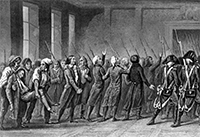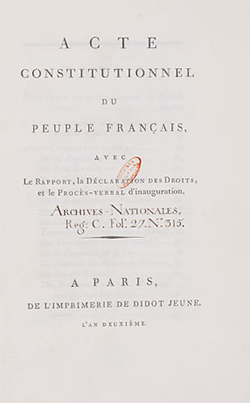The French Constitution of 1793
In light of the ouster of both the monarchy and the king, the National Convention had been tasked with replacing the Constitution of 1791, which had outlined a system of government rooted in constitutional monarchy. As the year 1793 progressed, the two leading factions in the Convention, the Girondins and the Montagnards, grew further and further apart in their political aims. The Girondins had a majority in the Convention, but the The Montagnard-dominated Convention then got to work on crafting the new constitution. Heading up a committee to write the constitution was Louis Saint-Just, one of the powers behind the Committee of Public Safety. The committee produced a draft in eight days. The final version, decreed on June 24, advanced further the cause of political democracy adding to the pronouncements of the Declaration of the Rights of the Man and of the Citizen such principles as the specific application of all laws to all people equally and the institution of universal manhood suffrage without any requirement of property ownership, pertaining to both voting and holding office. A 24-member executive council, nominated from across the country, headed up the executive arm of the government. The power of this council was "limited to the execution of laws and decrees of the legislative body." Making up the judiciary would be justices of the peace and public arbitrators, all chosen by the public and all serving one-year terms. The new constitution delineated between laws and decrees. Among examples of laws were these:
Among examples of decrees were these:
Among the other provisions of the Constitution of 1793:
The last of the 124 provisions of the Constitution were all about guaranteeing rights:
A popular vote of July 1793 ratified the Constitution, and the Convention officially adopted it on August 10. Accompanying the new Constitution was a new Declaration of the Rights of Man and of the Citizen. For all of its expansion of rights and guarantees and protections, the Constitution of 1793 was in effect for just a few months. Enacted in the middle of the War of the First Coalition as it was, it gave way to a revolutionary government, proclaimed in October, which took the form of the Reign of Terror for more than a year and then gave way to the Directory and another updated Constitution. Future uprisings, however (particularly the Revolutions of 1848), hearkened back to the tenets espoused in the Constitution of 1793.
|
|
Social Studies for Kids
copyright 2002–2026
David White



 Montagnards had more support from the
Montagnards had more support from the  "the civil and penal legislation
"the civil and penal legislation
